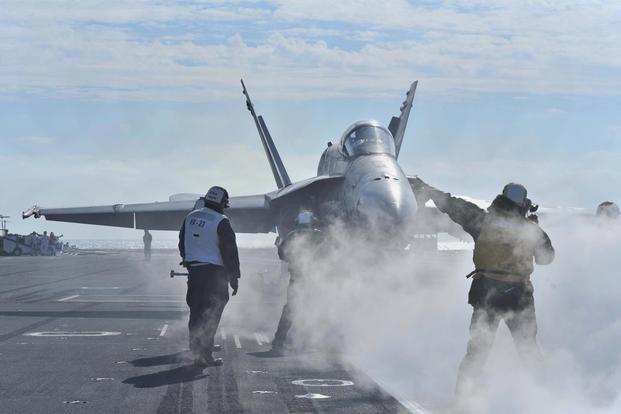Raytheon says its Joint Precision Approach and Landings System, or JPALS, is revolutionizing landings at sea for the first two deployed squadrons of the F-35B Joint Strike Fighter.
Now, the company is setting its sights on the Air Force, where JPALs, already installed on the service's F-35A, could help take the guesswork out of landings at austere airfields with little infrastructure, and in bad weather conditions.
Brooks Cleveland, the senior aviation adviser for landing systems at Raytheon and a former Navy F/A-18 Hornet pilot, said Raytheon wants to take a "road show" demonstration of JPALS capabilities to Hill and Luke Air Force bases, two major F-35 operations hubs.
"On the F-35A, [JPALS] is in there and it's turned on, but there's no land-based system yet," Cleveland said. "It will be demonstrating that it's in there and it works as it does at sea, on an aircraft carrier."
JPALS works by enabling communication between a landing aircraft and systems on the ship or ground that can guide the plane in safely and accurately, even on a pitching ship deck or a zero-visibility landing zone. Since the JPALS-equipped F-35B embarked on historic first shipboard deployments with the 31st and 13th Marine Expeditionary Units earlier this year, Cleveland said the system has been 99.9 percent reliable.
"To us on the ships, it's unheard of," he said. "Just off the top of my head, about one out of every three times I came back, the landing systems weren't working, so you're just doing it by sight, which is kind of frustrating, off an eight-hour mission. [The pilots] love it, so that's been very successful."
JW Watkins, a business development manager for Raytheon and a retired Air Force colonel who flew F-16 Fighting Falcons, said the Air Force could put the system to work in the austere environments it operates in all over the world.
"What the Air Force will do is, they'll get the contingency response group to take a very small group of folks into wherever, whether it's a road in Poland or a bare base somewhere in Africa or the Middle East somewhere, and bring in a system like JPALS," he said.
JPALS ground components can be set up within 90 minutes and can offer pilots 50 different possible approaches at multiple airfields within a radius of 20 nautical miles, Watkins said.
Approaches, he said, can be tailored to accommodate challenging terrain or hazardous weather.
Cleveland said it's not just about taking the complexity out of landings; it also offers a level of greater safety to pilots.
"Something like this, it doesn't matter what the weather is, you could launch everybody, knowing that they're going to come back safely," he said.
Raytheon is eyeing sometime next year for the possible F-35 road show demonstration. Watkins said Air Force officials have asked about the possibility of deploying an expeditionary JPALS setup on other planes, including the F-16, F-15 Eagle, cargo aircraft and rotorcraft.
Cleveland said most aircraft have the basic infrastructure needed to work with JPALs, with some modifications.
"It's a task, but not complex," he said. "It's not this massive, huge-scale, 'we have to flight test and certify because we're taking added things on.' But it's still something we have to solve because every airplane has a different radio ... [and] industry partners to work with. It's challenging, but certainly not insurmountable."
-- Hope Hodge Seck can be reached at hope.seck@military.com. Follow her on Twitter at @HopeSeck.
Related video:










